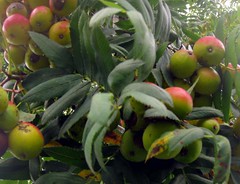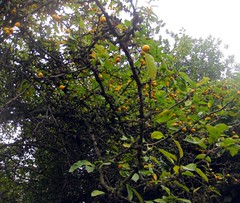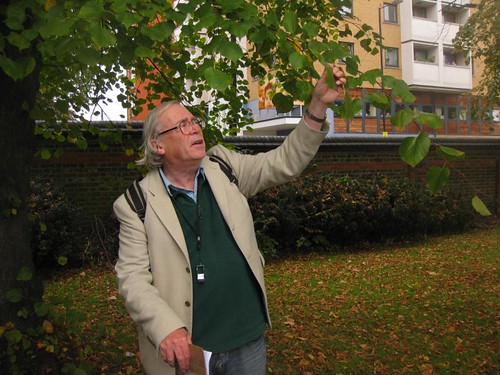Here's a little mystery for you history detectives to solve.
In the grounds of St Ann's Hospital are a large number of planted rare and interesting trees but nobody knows who was responsible for deciding the detail of the tree planting, remarkable for its wide variety and the amount of edible fruit trees selected. The only clue I can give you is that the planting was done in the 1920s. The organisers of Tuesday's tree tour would love to hear from you if you can unearth the answer.

Over 50 staff, service users and local people gathered in the grounds of the Hospital to listen to Haringey treasure, botanist David Bevan, give an entertaining and highly informative talk about the wonderful trees.
We began with the stars of the show, the twelve True Service trees. St Ann's has the finest True Service trees in North London (in fact you have to travel to the Wyre Forest to see better). It is an uncommon tree in Britain and wild trees are extremely difficult to find but there is a wild True Service tree in Railway Fields, the only one in London, which was probably seeded by a local bird.
The True Service has edible fruit which either resembles small apples or pears but it is not until the skin has turned a leathery brown and looks over ripe that the fruit is good to eat, in fact it is recommended to wait until the first frosts to harvest them. It tastes of a pear flavoured chocolate by the way.

It can be turned into an alcholic cider-like drink known as cerevisia to the Romans from which the name of the tree is thought to derive.


There are a number of Mulberry trees on the site. Some of the staff admitted that during the fruit season in July, lots of people can be seen dotted with the tell tale red stains of the Black Mulberry where they've been 'scrumping'
Another rarity for North London, was the Strawberry Tree. Although a native of the British Isles, you usually have to go to the West of Ireland to see it. The fruit is quite tart but those who tried it said it was rather nice.
There are also lots of crab apple trees which formed a sort of odd link with my encounter with the wartime table at Markfield Park where the art of making crab apple jelly was being demonstrated. We also found damsons, sweet chestnuts and lime trees, the young leaves of which make a good salad leaf.

There is a large patch of protected woodland at the back of the hospital backing onto the railway line, home to much local wildlife and native trees. David, in his time working at Haringey Council was responsible for getting the protection for this land as well as developing Railway Fields, so David has a special place in Harringay natural history.
Alas, I had to reluctantly drag myself away to pick up the small one from nursery but the rest of the party continued to explore. However, there will be more opportunities to learn about the trees. There are plans to do some tree conservation such as coppicing as well as harvest the fruit. Gemma from Urban Harvest has promised to keep us informed of upcoming events so watch this space...

In the grounds of St Ann's Hospital are a large number of planted rare and interesting trees but nobody knows who was responsible for deciding the detail of the tree planting, remarkable for its wide variety and the amount of edible fruit trees selected. The only clue I can give you is that the planting was done in the 1920s. The organisers of Tuesday's tree tour would love to hear from you if you can unearth the answer.

Over 50 staff, service users and local people gathered in the grounds of the Hospital to listen to Haringey treasure, botanist David Bevan, give an entertaining and highly informative talk about the wonderful trees.
We began with the stars of the show, the twelve True Service trees. St Ann's has the finest True Service trees in North London (in fact you have to travel to the Wyre Forest to see better). It is an uncommon tree in Britain and wild trees are extremely difficult to find but there is a wild True Service tree in Railway Fields, the only one in London, which was probably seeded by a local bird.
The True Service has edible fruit which either resembles small apples or pears but it is not until the skin has turned a leathery brown and looks over ripe that the fruit is good to eat, in fact it is recommended to wait until the first frosts to harvest them. It tastes of a pear flavoured chocolate by the way.

It can be turned into an alcholic cider-like drink known as cerevisia to the Romans from which the name of the tree is thought to derive.


There are a number of Mulberry trees on the site. Some of the staff admitted that during the fruit season in July, lots of people can be seen dotted with the tell tale red stains of the Black Mulberry where they've been 'scrumping'
Another rarity for North London, was the Strawberry Tree. Although a native of the British Isles, you usually have to go to the West of Ireland to see it. The fruit is quite tart but those who tried it said it was rather nice.
There are also lots of crab apple trees which formed a sort of odd link with my encounter with the wartime table at Markfield Park where the art of making crab apple jelly was being demonstrated. We also found damsons, sweet chestnuts and lime trees, the young leaves of which make a good salad leaf.

There is a large patch of protected woodland at the back of the hospital backing onto the railway line, home to much local wildlife and native trees. David, in his time working at Haringey Council was responsible for getting the protection for this land as well as developing Railway Fields, so David has a special place in Harringay natural history.
Alas, I had to reluctantly drag myself away to pick up the small one from nursery but the rest of the party continued to explore. However, there will be more opportunities to learn about the trees. There are plans to do some tree conservation such as coppicing as well as harvest the fruit. Gemma from Urban Harvest has promised to keep us informed of upcoming events so watch this space...

-
Comment by Liz on October 14, 2010 at 15:52
-
BBC weather suggests frost this weekend, time to start the True Service harvest!
-
Comment by Angela on October 14, 2010 at 19:20
-
That's really interesting Liz!
Was the planting definitely done in the 1920s? (I don't wish to doubt David's expertise obviously) but apparently the hospital originally consisted of temporary huts and was completely reconstructed during the 1930s.
-
Comment by Liz on October 14, 2010 at 19:57
-
He said that the trees were 80 to 90 years old which I presume he deduces from being a botanist, but he did also say that he would love an answer to the question, so if anyone can unearth any evidence that places them at a different time, it would be gratefully received.
-
Comment by StephenBln on October 14, 2010 at 21:33
-
If my memory serves me correctly, the 1930s building were added to join up the earlier edwardian? wards.. I imagine the trees were planted 1910-25..
On my picture here: they look older than 20 years (Liz also has some comparison shots)
-
Comment by Liz on October 15, 2010 at 11:48
-
The woodland and (maybe the trees on the perimeter?) are probably older and may date from the land's pre-hospital days perhaps. There are some very large trees by the railway line which appear to my untrained and unqualified eye to be older than 80 years, if you compare them with the planted oak and chestnut trees in the middle of the grounds. I think I saw mention of a winter tree tour somewhere so could find out then. These are the same perimeter trees from Steve's photo as they looked in Winter last year.
-
Comment by Dick Harris on October 15, 2010 at 12:06
-
The true Service trees and most of the other trees we saw are mostly at Google maps 51.581057,-0.089693 and points further east and south. Not therefore visible from Warwick Gardens.
I too wondered about the age of the trees we were looking at. I knew nothing about Service trees before this but near the first group was a pear tree that David Bevan thought could be of a similar age. I would have guessed it was later than 1920s rather than earlier. On the other hand, one of the mulberry trees could have been considerably older. I wonder what was on this site before the hospital came in 1892.
-
Comment by Angela on October 15, 2010 at 12:52
-
According to British History Online, there were a number of lodges/villas here before the hospital was built, one of which iirc was St John's Lodge where Charlotte Riddell lived.
-
Comment by StephenBln on October 15, 2010 at 13:23
-
I'd forgotten about the Mulberry trees in the hospital grounds, but in the 1960s I and other kids at Woodlands Park School used to be sent every year to the hospital to collect leaves for our silk worms..
-
Comment by Liz on October 15, 2010 at 18:48
-
Nice memory Steve, the people behind the tree tour would love to hear that. I'll be sure and pass it on.
History:
By 1875 villas around St. Ann's had been built on ground recently deemed an irreclaimable morass and West Green had been transformed: 'the old village is still there, but it is huddled up against Streets, and Villas, and Places, and all other devices of modern investors'. In consequence the population of the parish more than doubled during the 1870s
Charlotte Riddell hated the development
The hospital itself was built in 1892 by the Metropolitan Asylums Board as the North Eastern Fever Hospital. It became a general hospital in 1948 after the N.H.S.took over.
"The hospital, which had been established against strong local opposition, originated in temporary buildings erected during a scarlet fever epidemic and occupying 19 a. on the south side of St. Ann's Road. Permanent blocks were completed in 1900 and 548 beds were planned in 1901, by which time the site had been enlarged to 33 a. The L.C.C. took over responsibility in 1930 and replaced the remaining huts before the Second World War. In 1948 St. Ann's assumed its modern name, on becoming a general hospital. In 1973, when it was under the Tottenham management committee, it occupied 28 a. and had 586 beds."
So the tree planting would, maybe, have been by the London County Council in 1930 but who was the inspired gardener who made such interesting choices?
-
Comment by Gina O on October 15, 2010 at 21:55
-
This is really interesting - I wish I could have made it to the tour as this is obviously the best time of year for it. I'll definitely be on the lookout for the next one. Whereabouts in the grounds are the True Service trees as I'd like to see them for myself while they are still in fruit (and check out whether they really taste of chocolate and pears!).
By the way, does anyone know what is done these days with the fruit? Is it harvested? I've always thought that getting some of the patients involved in harvesting/looking after the trees etc would be excellent therapy.
Also, how do I get in touch with David? I live behind the hospital and would like to ask him some questions about the "protected woodland" at the back of the hospital.
© 2024 Created by Hugh.
Powered by
![]()
You need to be a member of Harringay online to add comments!
Join Harringay online